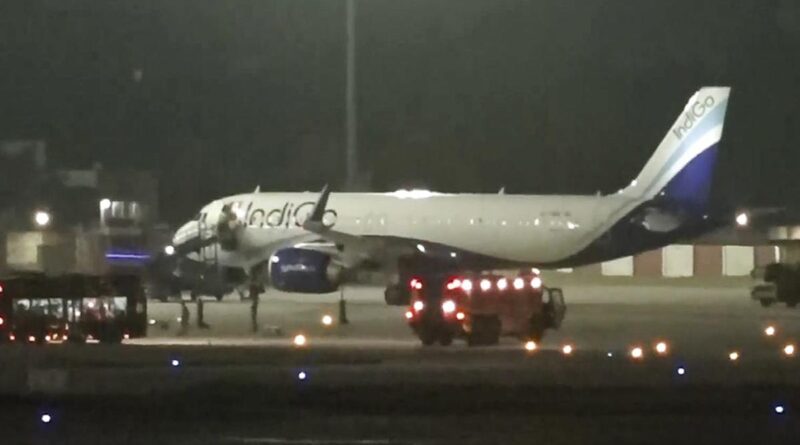What is the flight protocol for a bomb threat?

An Indigo aircraft from Saudi Arabia after it made an emergency landing following a bomb threat at Jaipur airport on October 15, 2024.
| Photo Credit: PTI
The story so far:
Over nearly two weeks, almost all Indian carriers including the Tata group airlines — Air India, Vistara, and Air India Express — as well as Indigo, Alliance Air, and Star Air have faced a wave of threats, resulting in emergency responses and rerouting. There has been military fighter jet interception of some of the flights when they were in international airspace after the crew squawked an emergency transponder code. While all the threats have been determined to be a hoax, they have still led to significant flight delays and financial losses to the airlines, about ₹13 lakh-₹17 lakh an hour.
What do we know about the threats?
According to the Union Civil Aviation Minister, Kinjarapu Rammohan Naidu, most threats have been through social media. Intelligence agencies are looking into the issue and there is a strong possibility of cases being registered. As the threats are largely of an online nature, the tracking of IP addresses and virtual private network use are in focus. The Minister added that even if intuition was that it could be a hoax, nothing was being left unchecked. India has nearly 4,000 flight operations in a day, he said, and within the timeline since the threats began, this would mean over 275 threats for 48,000 flights. He said that efforts were on to make changes in the aviation laws in order to have a strong framework in place. There has been one detention so far — of a teenager who made hoax calls. Representatives of some of the social media platforms concerned have indicated that they are “committed to crack down on terror threats being made against Indian flights”.
What is the aviation security architecture?
Almost all the main security guidelines and directives are rooted in the International Civil Aviation Organization’s (ICAO) Annex 17–Aviation Security (Restricted). An ICAO spokesperson told The Hindu that the formulation and adoption of Standards and Recommended Practices (SARPs) for international civil aviation are important, which are detailed in technical annexes to the Convention on International Civil Aviation — also called the Chicago Convention. The ICAO has measures against acts of ‘unlawful interference against civil aviation throughout the world’. The SARPs for international aviation security form Annex 17 to the Chicago Convention.
There is also the ICAO Aviation Security Manual (Doc 8973–Restricted) which assists ICAO member-states. The spokesperson said that Annex 17 and Doc 8973 are under constant review keeping in mind new threats and evolving technological developments. The spokesperson added that there are restrictions to the information on (member-) state discussions regarding the evolution of security matters, the resulting assessments, and the associated mitigation measures. Specific ICAO guidance on security matters is restricted.
In India, the nodal agency concerned is the Bureau of Civil Aviation Security. Its main responsibility is to have in place standards and measures for the security of civilian flights. The Directorate General of Civil Aviation (DGCA) is concerned with safety. Other agencies involved, directly and indirectly, include the Airports Authority of India; the Central Industrial Security Force; the National Security Guard; the Intelligence Bureau; the Research and Analysis Wing; the Ministry of Home Affairs, and the higher judiciary.
In the context of the threats, amendments could be planned to the Aircraft Act 1934, the Aircraft Rules 1937, and subordinate pieces of legislation to ensure stringent punishment and placing offenders on a ‘no-fly list’. The Minister highlighted planned amendments to the Suppression of Unlawful Acts against Safety of Civil Aviation Act, 1982, which would allow legal action even when the aircraft is on the ground. Regulations now focus on in-flight incidents.
An official said that in every airport, the operator, airlines, and security agencies have procedures to handle security threats based on approved documents. He said, “Every airport is prepared to handle such situations as the procedures are regularly tested and updated.” There are specific documents but they are restricted. Contingency procedures for unusual occurrences include bomb threats (and aircraft isolation), hijacks, radio communication failure, and other emergencies associated with aircraft.
A pilot who flies the Boeing 777 aircraft says a threat is taken very seriously and there are procedures for the crew. Air traffic control agencies also have procedures.
How are threats to be handled?
An aviation security expert who served in various geographical domains has told The Hindu that hoax calls are of a specific or non-specific nature. While specific details about the hoax calls in the Indian context might not be publicly available, the issue has highlighted systemic issues that concern standardised procedures, guidelines, training, technological limitations, communication gaps, and regulatory challenges.
Tackling hoax calls, for instance, according to the expert, would require investment in technology such as advanced call tracking systems, AI-powered call analysis, voice stress analysis, comprehensive threat assessment, and rewards and incentives for informers. The expert says the industry must look at emerging technologies such as quantum computing, having an aviation cybersecurity framework, pitching for a global hoax call database, having AI-powered chatbots for initial threat assessment, and putting in place enhanced psychological profiling of callers.
An aviation safety expert and a former member of the Civil Aviation Safety Advisory Council suggests placing the photographs of offenders on social media and on display at airports.
Published – October 27, 2024 03:46 am IST

